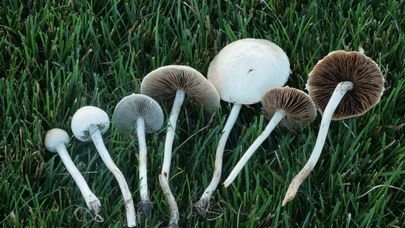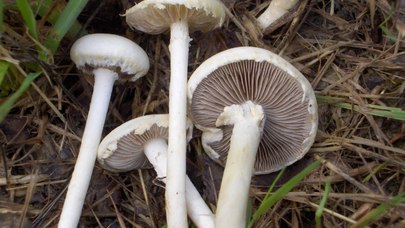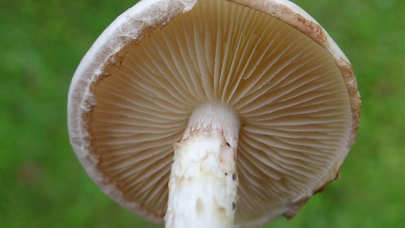Agrocybe dura
Description
Agrocybe dura is a species of Fungi in the family Strophariaceae. Grows in grassy areas, especially in late spring and early summer, in that painful gap between spring mushrooms and summer mushrooms, when mushroom enthusiasts in temperate climates are frothing at the bit. Agrocybe dura isn't limited to this period, but that's when it is most likely to appear.
The cap is medium-sized and more or less white, and the stem features a flimsy ring. These features will help to separate it from Agrocybe pediades, which also appear in grass but has a smaller, pale yellow-brown cap and lacks a ring. Under the microscope, Agrocybe dura features fairly large spores.
Agrocybe praecox is considered edible if well cooked, but it is said by some to retain a bitter taste and is of very poor quality.
Common names: Bearded Fieldcap.
Mushroom Identification
Ecology
Saprobic; growing alone, scattered, or gregariously in the grass (lawns, meadows, fields); sometimes appearing in fairy rings; appearing from spring through fall, but most likely to be seen in May, at least in temperate climates; widely distributed in North America and Europe.
Cap
2.5–8 cm; convex at first, becoming broadly convex or nearly flat; tacky when fresh, but soon dry; bald; often becoming cracked or fissured in old age; usually whitish overall, or with a dull yellowish center—but sometimes creamy to dull yellowish overall; the margin often adorned with whitish to yellowish partial veil fibrils and remnants.
Gills
Narrowly attached to the stem; close or crowded; short-gills frequent; whitish at first, becoming dull grayish brown; edges faintly whitish at maturity; at first covered by a white partial veil.
Stem
5–10 cm long and 3–15 mm thick; more or less equal; rigid; bald or a little fibrillose; whitish, sometimes discoloring brownish, especially in the bottom half; with a flimsy, ephemeral, whitish ring; basal mycelium white.
Flesh
White; unchanging when sliced.
Odor and Taste
Not distinctive.
Chemical Reactions
KOH on cap surface negative to yellowish.
Spore Print
Brown.
Microscopic Features
Spores 11–16 (–19) x 6–9 (–10) µm; more or less ellipsoid, with one end, flattened for a 2 –3 µm pore; smooth; walls about 1 µm thick; brownish orange to orangish-brownish in KOH; brown in Melzer's. Basidia 25–35 x 7–9 µm; clavate; 4-sterigmate. Cheilocystidia 35–60 x 10–25 µm; utriform to widely utriform; smooth; thin-walled; hyaline in KOH. Pleurocystidia 35–55 x 10–20 µm; widely utriform to clavate or sphaeropedunculate; smooth; thin-walled; hyaline in KOH. Pileipellis hymeniform but quickly deteriorating and collapsing (best seen on very young caps); hymeniform elements 15–22 x 6–10 µm; clavate to pyriform; hyaline in KOH.
Look-Alikes
-
Also occurs in spring and summer, has a smooth dark cap, rarely cracks, and has smaller spores.
Agrocybe cylindracea
Grows on poplar and willow stumps.
History
In 1828 German naturalist Wilhelm Gottfried Lasch (1787 - 1863) first described this species and give it naming Agaricus molestus.
In 1978 German-born American mycologist Rolf Singer reassigned this mushroom to the genus Agrocybe, thus establishing the scientific name Agrocybe molesta.
'Fieldcap' is derived from agro-, fields and -cybe, head or cap, and is therefore a direct translation of the Agrocybe genus name. The specific epithet molesta comes from Latin and means "troublesome" or "irksome."
Synonyms
Agaricus durus Bolton, 1788 (basionym)
Agaricus molestus Lasch, 1828
Agaricus vermifluus Peck, 1897
Agrocybe dura var. xanthophylla (Bres.) P.D.Orton, 1960
Agrocybe molesta (Lasch) Singer, 1978
Agrocybe vermiflua (Peck) Watling, 1976
Dryophila dura (Bolton) Quél., 1886
Hylophila dura (Bolton) Quél., 1888
Pholiota dura (Bolton) P.Kumm., 1871
Pholiota dura var. xanthophylla Bres., 1892
Pholiota vermiflua (Peck) Sacc., 1887
Togaria dura (Bolton) W.G.Sm., 1908
Photo sources:
Photo 1 - Author: Jerzy Opioła (CC BY-SA 4.0)
Photo 2 - Author: Rocky Houghtby (CC BY-SA 3.0)
Photo 3 - Author: vesna maric (kalipso) (CC BY-SA 3.0)
Photo 4 - Author: Jerzy Opioła (CC BY-SA 4.0)




